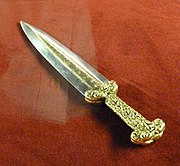Uyuk culture
52°04′18″N 93°37′55″E / 52.071606°N 93.631836°E
Kokel Culture |
Arzhan 2
.The Uyuk culture refers to the
Tuva Republic.[1]
Cultures
This period of Scythian culture covers a period from the 8th century BCE to the 2nd century BCE.[1] The successive phases of the Uyuk culture are:
- the Arzhan culture(9th-8th century BCE)
- the Aldy-Bel culture (7th-6th century BCE)
- the Sagly-Bazhy culture/ Chandman culture (5th–3rd centuries BCE).[1]
These Saka cultures would ultimately be replaced by the
Kokel Culture.[1]
Nearby Saka cultures were the
.The culture of Tuva in the Scythian era is presented in Hall 30 of the State Hermitage Museum.[3] It stopped to exist in the 2nd century BCE as a result of Xiongnu invasions.[4]
-
Arzhan 2 kurgan (7th-6th centuries BC, associated with the Aldy-Bel culture).[5]
-
Curled-up feline animal from Arzhan-1, circa 800 BCE.[6]
-
"Animal style" deer of theArzhan culture, (7-6th century BC) Tuva.
-
Pectoral plate, from burial mound Arzhan (7-6th century BC) Tuva.
-
Akinak (dagger) burial moundArzhan culture(7-6th century BC), Tuva.
-
Arzhan-2 gold bracelet, Tuva National Museum.
Genetics
A 2020 study analyzed the DNA of Chandman fossils (late Uyuk culture), and described them as a mixed Eurasian population, with 50% of their ancestry being derived from the West Eurasian
Iranian plateau.[8]
The
Slab Grave culture, while retainers of comparatively lower status had high genetic heterogeneity, representing influxes from the many parts of the Xiongnu Empire, and included a large proportion of Chandman-related individuals.[9]
References
- ^ ISSN 1875-371X.
Uyuk culture [9, 12]. It derives its name from the Uyuk river, the valley of which, primarily within the Turan-Uyuk depression, is home to gigantic stone and earth kurgans with graves of tribal chiefs.
- ^ Murphy, Eileen M. (2013). "Iron Age pastoral nomadism and agriculture in the eastern Eurasian steppe: Implications from dental palaeopathology and stable carbon and nitrogen isotopes". Journal of Archaeological Science.
- ^ "Tuva in the Scythian Era (Hall 30)". State Hermitage Museum.
- ^ "The Culture of Tuva in the Scythian Era (Hall 30)". State Hermitage Museum.
- .
- ISBN 1-4020-2655-2.
p.24 "Figure.2. Royal barrow Arzhan 1: funeral artifacts. 36-39"
- ISSN 0092-8674.
- ^ PMID 33157037. See Fig. 4, A and B.
- PMC 10104459.
In this genome-wide archaeogenetic study, we find high genetic heterogeneity among late Xiongnu-era individuals at two cemeteries located along the far western frontier of the Xiongnu empire and describe patterns of genetic diversity related to social status. Overall, we find that genetic heterogeneity is highest among lower-status individuals. In particular, the satellite graves surrounding the elite square tombs at TAK show extreme levels of genetic heterogeneity, suggesting that these individuals, who were likely low-ranking retainers, were drawn from diverse parts of the empire. In contrast, the highest-status individuals at the two sites tended to have lower genetic diversity and a high proportion of ancestry deriving from EIA Slab Grave groups, suggesting that these groups may have disproportionately contributed to the ruling elite during the formation of the Xiongnu empire." (...) "a chanyu, or ruler of the empire. Like the elite women at the western frontier, he also had very high eastern Eurasian ancestry (deriving 39.3 and 51.9% from SlabGrave1 and Han_2000BP, respectively, and the rest from Chandman_IA; data file S2C)" (...) "Chandman_IA was representative of people in far western Mongolia associated with Sagly/Uyuk (ca. 500 to 200 BCE), Saka (ca. 900 to 200 BCE), and Pazyryk (ca. 500 to 200 BCE) groups in Siberia and Kazakhstan.

![Arzhan 2 kurgan (7th-6th centuries BC, associated with the Aldy-Bel culture).[5]](http://upload.wikimedia.org/wikipedia/commons/thumb/a/a5/%D0%90%D1%80%D0%B6%D0%B0%D0%B0%D0%BD_-_2.JPG/180px-%D0%90%D1%80%D0%B6%D0%B0%D0%B0%D0%BD_-_2.JPG)
![Curled-up feline animal from Arzhan-1, circa 800 BCE.[6]](http://upload.wikimedia.org/wikipedia/commons/thumb/0/02/Arzhan_animal_ring.jpg/180px-Arzhan_animal_ring.jpg)



